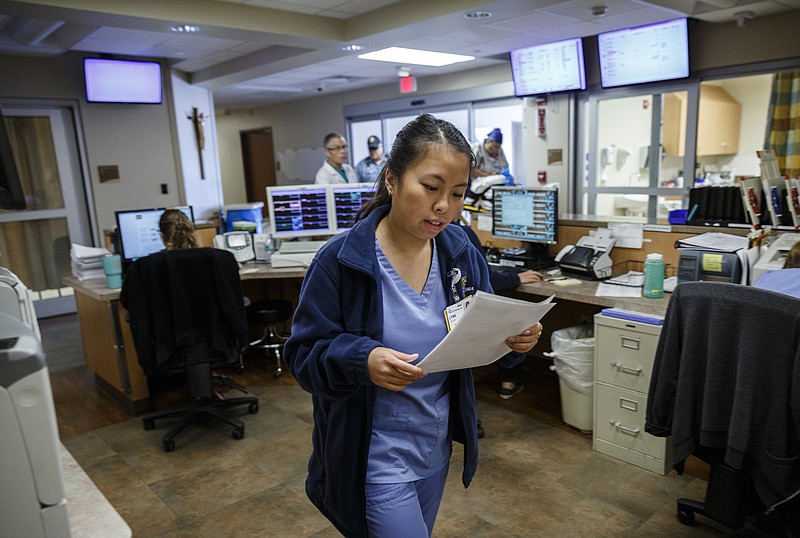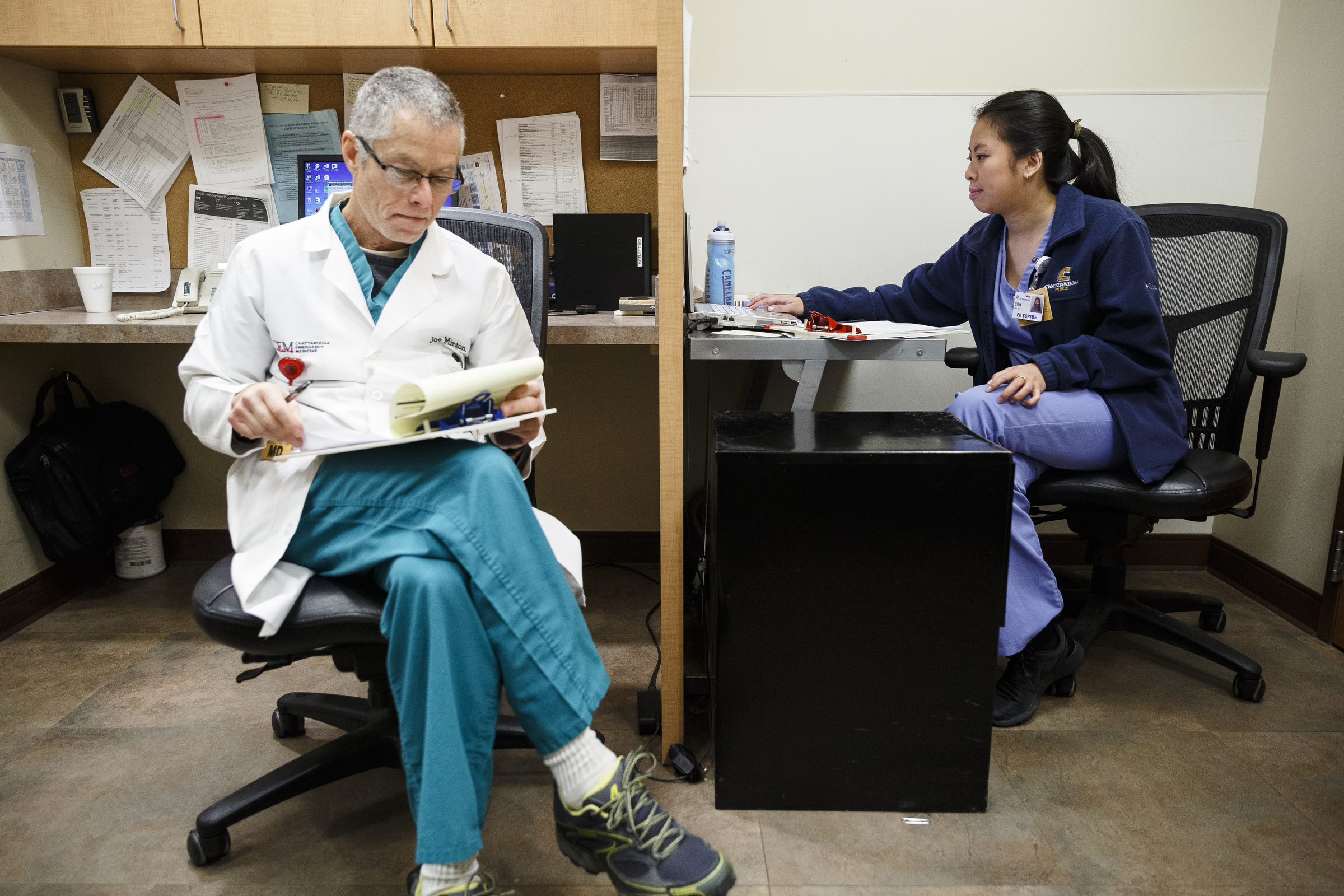If you have ever struggled to read a doctor's handwriting and wondered if there isn't a better way, the answer is yes. A relatively new health care profession, called a medical scribe, is showing up in more and more U.S. hospitals, driven less by poor physician penmanship than by an increasing need for doctors to capture what they do on a computer.
Doctors have long complained that while the most important part of their job is examining a patient, ordering tests, and coming up with a treatment plan, too much of their time is taken up documenting what they do. Sometimes that results in bad handwriting. Other times it leads to burnout as physicians struggle to enter data in an electronic medical record that they may not need for their analysis, but that the hospital needs in order to be reimbursed by an insurance company, Medicare or Medicaid.
"The electronic medical record is something that all doctors detest," said Dr. David Stern, dean of the University of Tennessee College of Medicine. "It is cumbersome. And instead of the doctor looking into your face, he or she is often typing, looking down. It is almost a barrier to interaction rather than something that facilitates interaction."
Enter the medical scribe, a cross between a court reporter and a personal secretary.
Scribes follow doctors on their rounds, from patient to patient, armed with clipboards or laptops.
"I look at the patient's chart before going to the patient's room, and then I hand the chart to my scribe," said Dr. Deann Champion, co-medical director of the emergency room at CHI Memorial. "I can concentrate on talking to the patient - we're having a conversation. And as I'm asking questions and the patient is answering, the scribe is documenting all of this."
"From the moment when we walk in and the patient starts talking about how they are feeling, the questions the doctor asks - 'what medicines do you take, why do you take them?' - I document all of that," said Lynn Tran, a University of Tennessee biology major who works with Champion at CHI Memorial.
Tran is a typical scribe - a smart undergraduate who is interested in a career in medicine and jumps at the chance to see what life in a hospital is really like.
"When you hire a college student who is pursuing a pre-professional degree, they generally are pretty smart kids," Champion said.
"Being a scribe is so close to like the real medical world," Tran said. "You are literally with the doctor, attached to the hip, getting to see how their mind works, from the minute they see a patient, describing what's wrong with the patient, and what they will do for the patient. It is really amazing to see."
While CHI Memorial has been using scribes in its operating room for about seven years, they are now popping up all over the U.S. in different areas of a hospital.
The use of scribes got a huge boost in 2009 with the passage of the American Recovery and Reinvestment Act. That law gave health care providers five years to demonstrate "meaningful use" of electronic medical records if they wanted to keep their Medicaid and Medicare reimbursement levels.
Even most doctors concede computerizing hospital records is critical.
"The electronic medical record is a very important tool," UT's Dean Stern said. "How can you tell what we did and if what we did led to better outcomes? We have to have that."
But doctors frustrated by the increasing time they are spending entering data into computers are now turning to scribes.
Some 18,000 people across the U.S. now work as scribes, according to the American College of Medical Scribe Specialists, a nonprofit organization based in Orange County, Calif.
Since scribes normally work only in one specialty area of a hospital, they need to learn only a narrow portion of what a hospital does in order to be effective. They are given a list of medical terms to learn, and they shadow other scribes to learn to fill out the forms, whether on paper or computer.
A major concern is to be certain the doctor and hospital document what they do in a way that meets the demands of insurance companies, Medicare and Medicaid.
But the way the insurers want data is not at all the way a doctor may need it.
"If it were just about patient care and can the patient's [family doctor] read my notes, it would be in paragraph form - this is what I heard, what I did, what I saw," said Will Bible, a former scribe at CHI Memorial who went on to become a physician's assistant and now is back in the same emergency room in that role. "You have your thoughts ,which are logical and in a certain order, but the payment side wants it fragmented and documented in certain ways. It is almost like doing a tax return - you have weird boxes in one part, and 'See Page 3 for my procedure notes.'"
But having someone paying attention to what insurers want can be a huge help to the doctor and the hospital.
"The ER is a very busy place and keeping all of your plates spinning at the same time, remembering what patient is doing what and when, when you are managing 12 patients at a time gets challenging," Champion said. "If [scribes] can remind us of our documentation for billing, if they can keep us from getting down-coded on a couple of patients a day, they pay for themselves." "Down-coding" occurs when an insurer refuses to pay what a hospital has requested, claiming the hospital has not documented that it performed the services for which it is seeking reimbursement.
Scribes also do more than just enter data into the computer. They sometimes are general assistants, checking for lab test results or letting doctors know that a consulting physician is available on the phone. While nurses are assigned to specific areas of a hospital, the scribe is assigned to follow a particular doctor.
The benefits of using scribes have been documented by research. One study, published in ClinicoEconomics and Outcomes Research in 2013, looked at cardiologists who used scribes. It found that doctor-patient interaction was "significantly improved" by such measures as face-to-face time, which increased by more than five minutes per appointment.
A follow-up study in the same journal last year reported that the cardiologists who used scribes also saw 9.6 percent more patients per hour. That translated into $1.4 million in extra revenue for each cardiologist annually.
Some observers, however, are wary of potential pitfalls, including the possibility that doctors will allow scribes to order medications or further treatment without proper oversight.
"There is a substantial risk of unintended functional creep, of letting scribes enter verbal orders," warned an opinion piece in JAMA, the Journal of the American Medical Association, in 2014.
For now, most scribes only spend a couple of years in the job before going back to school for a medical career. Tran, for example, only started work in August but she is already applying for physician's assistant school and expects to work as a scribe for no more than another year. Bible worked for three years as a scribe before moving on to get his physician's assistant degree.
But some universities are including scribe training as part of a two-year degree as a medical assistant. Medical assistants are allowed to provide some patient care, such as administering vaccines, in addition to scribe work, so staffers may see that as a career and not a stepping stone to medical or nursing school.
Locally, only CHI Memorial uses scribes for now, and there only in the emergency room. But Erlanger hospital is entering the final stages of computerizing its records, and CHI Memorial is just beginning that process.
If the experience of hospitals elsewhere that have computerized is any indication, demand for scribes locally will increase.
While UT's medical school does not yet have a program to train scribes, Dean Stern understands the appeal.
"A doctor finishes seeing patients at 6 or 7 o'clock, and then they have to work until 9 or 10 at night to enter all of the information into this cumbersome computer," he said. "Scribes are allowing the doctor to use his or her time focused on the patient."
And scribes may also be a great way to convince a new generation of the rewards of a medical career.
"When someone has a heart attack, they come in and we save them," CHI Memorial scribe Tran said. "Someone comes in unconscious and you bring them back and they are alive and are talking again. Those small moments are so rewarding to see."
The Associated Press contributed to this story.
Contact staff writer Steve Johnson at 423-757-6673, sjohnson@timesfreepress.com, on Twitter @stevejohnsonTFP, and on Facebook, www.facebook.com/noogahealth.

